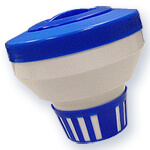We have a few pool chlorinator techniques that we want to share today. Some tips on how to precisely control the rate of feed of your chlorine, and some chlorinator maintenance and repair stuff, and a few thoughts on safety.
TYPES OF CHLORINATORS
Chlorine Floaters: Place up to 3 lbs of 3-inch tablets into the container, close the lid, adjust the baffle vent at the bottom, or drill holes in the side, and float it in the pool. Chlorine Floaters are the simplest and most inexpensive chlorinators. Their disadvantage is they are not as precise, nor as large, as Chlorine Feeders. Floaters are found in the $10-$20 range.
Chlorine Feeders: Place 3-inch tablets, up to 9 lbs, into the chamber and close the lid. Installed last on the line, after the filter and any other equipment, Chlorine Feeders are either plumbed In-line, glued into the PVC return line, or installed Off-line with thin hoses and injectors drilled into the pipe. Either way, adjust the chlorine flow with a dial that ranges from 1-10. Feeders range from $80-$110.
HOW TO USE A CHLORINATOR
Chlorine Floaters: For each 5000 gallons of pool water, add one 3″ chlorine tablet. Open the baffle or vent at the bottom, fully open. The wider open, the greater the dissolution rate.
The two variables you have to control with a floater are 1) the amount of tablets you put in, and 2) how far open (or closed), the baffles or vents are at the bottom. You
Your test kit will tell you for sure if you are using enough chlorine tablets. If your chlorine test is over 2.0 ppm, you may be able to use less tablets, or close the baffles more, and if your chlorine test is under 1.0 ppm, you should use another tablet, or open the vents more.
- Remove Chlorine Floaters when using the pool, if there will be any rough waters. You don’t want it tipping over and spilling it’s contents.
- Tie off the floater to a ladder or rope hook anchor. You don’t want it floating around and getting stuck on a ladder, skimmer or step.
- Be careful when the baffles are wide open, that the small slivers of tablets don’t fall out, which can stain both vinyl and plaster pools. Place slivers in the skimmer basket.
- You can use half tablets too, score them with a screwdriver, and break it in half with your hands, underwater in the skimmer basket.
Chlorine Feeders:
For each 5000 gallons of pool water, add one 3″ chlorine tablet, more or less. Choose a mid-point setting on the 1-10 dial. The higher the setting, the greater the dissolution rate.
A setting of 5 may be too high, and it depends on the number of tablets in the feeder. You could fill it full, with 15 tablets, and put it on a setting of 1-2, or add only 2 tablets and put it on a setting of 8-9.
Your test kit will help you determine the proper dial setting for your chlorinator. If you are in the habit of adding tablets once per week, experiment with dial settings and your test kit, to find the sweet spot of tablet concentration, and dial setting, to produce a consistent 1-2 ppm chlorine level.
- Chlorine Feeders are best installed In-Line, plumbed into the return line, when space on the return pipe is available. If not, an Off-Line model can be used just as effectively with slightly higher total cost of ownership, for new hoses/fittings every 5 years.
- Keep a Viton rubber chlorine feeder lid o-ring well lubricated, and replace if it becomes stretched or pinched.
- At season end, remove all chlorine pieces from the chlorinator, and store with a loose lid, to allow any residual chlorine gas to escape.
- Once per year, use a scraper tool to remove residue near the inside-top of the chemical feeder chamber, and clean any screens or inlet/outlet orifice
source: https://blog.intheswim.com/how-to-use-a-chlorine-floater-or-feeder/


